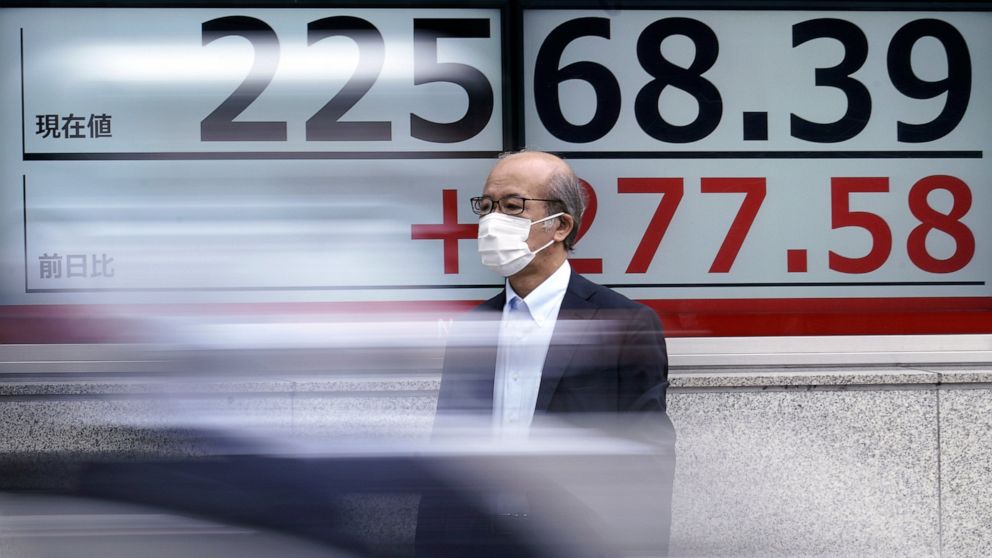An early gain for stocks evaporates as volatility continues
NEW YORK — Stocks gave up an early gain and turned lower Monday in another day of roller-coaster trading. The S&P 500 fell 0.9% after being up more than 1.6% earlier. Technology companies, which led the market higher in the morning, led it lower in the afternoon. Investors were discouraged to see that California extended a shutdown of bars and indoor dining and ordered gyms, churches and hair salons closed in most places as coronavirus cases keep rising. The renewed volatility came as companies prepare to tell investors how much less money they made, or lost, in the spring as the pandemic pounded the economy.
THIS IS A BREAKING NEWS UPDATE. AP’s earlier story appears below.
Stocks gave up an early gain and turned broadly lower on Wall Street Monday in another day of roller-coaster trading.
The S&P 500 was down 0.5% in late trading after giving up an earlier gain of 1.6%. It’s still close to its highest level since the market began selling off in late February due to virus worries. Bond yields pulled back after rising earlier.
The Dow Jones Industrial Average held on to a gain of 82 points, or 0.3%, at 26,153, as of 3:35 p.m. Eastern time, and the Nasdaq composite was down 1.7%, pulled down by weakness in technology stocks including Microsoft.
Earnings reporting season really gets going on Tuesday, when several of the country’s biggest banks are slated to report their results, including JPMorgan Chase. Across the S&P 500, expectations are almost universally dreadful.
Analysts say the biggest U.S. companies likely saw their earnings per share plummet nearly 45% from April through June, compared with year-ago levels. That would be the sharpest drop since the depths of the Great Recession in 2008, according to FactSet.
Investors are expecting banks, which traditionally kick off each earnings season every three months, to say they’ve had to set aside billions of dollars to cover loans potentially going bad due to the pandemic-caused recession, for example.
For energy stocks, whose earnings reports get going later in July, Wall Street expects profits to have disappeared completely. It’s not surprising given how prices in one corner of the U.S. oil market dipped below zero during the quarter as demand disappeared and storage tanks holding unused oil came close to maxing out.
Analysts likewise are forecasting an overall loss from companies that depend on consumers spending on non-essentials, such as cruise-ship operators and retailers, as their customers got locked away by stay-at-home orders.
Investors, though, largely seem willing to give a pass for such terrible results in the latest quarter and maybe even for a couple more.
“We — and many investors — expect the coronavirus-induced collapse in profits will be concentrated in 2020,” Goldman Sachs strategists wrote in a report.
Instead, investors are focusing on a hopeful return to profit growth in 2021 and beyond. The hope is that the economy and declines in corporate profits bottomed out in the spring and will continue to improve as governments have relaxed lockdown restrictions. The job market, retail sales and other measures of the economy have already begun showing some budding improvement.
Of course, all the optimism is colliding with fears that the recovery could be short-lived due to jumping coronavirus counts across global hot spots. Florida and other hard-hit states in the U.S. Sun Belt have been in the spotlight in particular, with the stock market often jerking suddenly lower following announcements there of rising numbers of known infections and deaths.
If states continue to bring back restrictions on their economies to slow the resurgence, it could choke off the fragile economic improvements just as they got underway.
“The most important thing is COVID-19 data,” said Darrell Cronk, chief investment officer of Wells Fargo Wealth and Investment Management. “That’s going to affect whether we have to slow down or stop economic activity in the back half of the year.”
Such concerns have helped the price of gold recently rally to its highest level since September 2011, shortly after it set its record. Gold added $12.20 to settle at $1,814.10 per ounce Monday.
Another measure of nervousness in the market also ticked higher. The VIX, which shows how much volatility traders expect from the S&P 500 in upcoming weeks, rose by 10.8%.
PepsiCo added 1.3% even though it said its profit fell 19% last quarter from a year earlier. Results were better than Wall Street had forecast, leading to the lift. But the company behind Frito-Lay and SodaStream also said the future looks so uncertain given the pandemic that it won’t offer any predictions about its sales and profits for the rest of the year.
The S&P 500 rose 1.8% last week. It has pulled back within 4.5% of its record, which was set in February, after being down nearly 34% in late March. The market has been stuck in a mostly up-and-down churn since early June, though, when it first got within 4.5% of its record.
Even though reports on the economy since early June have painted more improvements, worries are still high that the stock market has roared back to nearly record levels so much faster than corporate profits or the economy are expected to. Many economists and analysts say it could take years for that to happen, and the recent resurgence in coronavirus counts puts even that timetable in jepoardy.
European and Asian markets ended higher.
The yield on the 10-year Treasury held steady at 0.63%. It tends to move with investors’ expectations for the economy and inflation.
Benchmark U.S. crude fell 1.1% to settle at $40.10 per barrel. Brent crude, the international standard, fell 1.2% to $42.72 per barrel.
![]()


